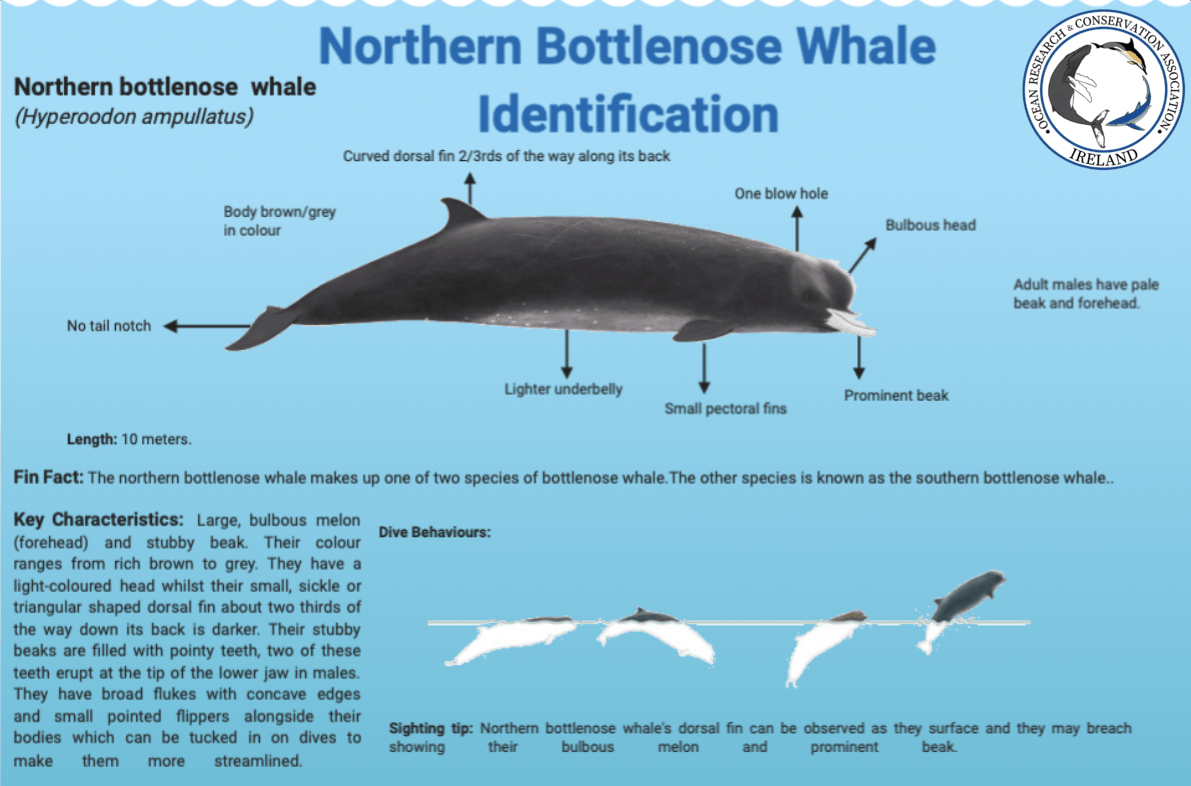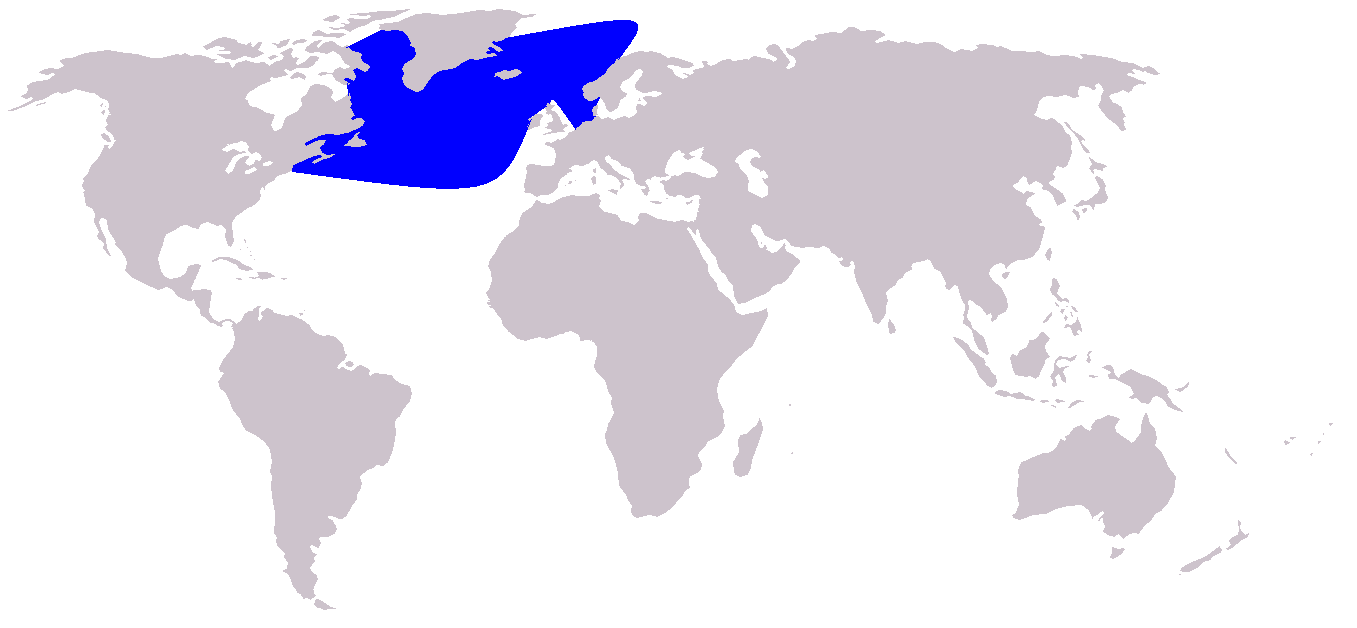Northern bottlenose whale (Hyperoodon ampulatus)
Classification:
Kingdom: Animalia
Phylum: Chordata
Class: Mammalia
Order: Cetacea
Family: Ziphiidae
Genus: Hyperoodon
Species: H. ampullatus
Get the facts:
The northern bottlenose whale (Hyperoodon ampullatus) is a species of beaked whale in the ziphiidae family. It is just one of two members of the genus Hyperoodon which also includes the Southern bottlenose whale. A part of the scientific name of this animal, 'ampullatus', means 'flask', indicating the head shape of this whale, which resembles a bottle
Species Identification:
Northern bottlenose whales can be distinguished by their large, bulbous melons (foreheads) and stubby beaks. The melons are particularly pronounced in males. Their colour ranges from rich brown to grey. They have a light-coloured head whilst their small, sickle or triangular shaped dorsal fin about two thirds of the way down its back is darker. They also have a dark grey back and sides and a lighter underside, a pattern used for camouflage which is often seen in cetaceans. Young are darker and northern bottlenose whales gradually get lighter in colour with age. Their stubby beaks are filled with pointy teeth, two of these teeth erupt at the tip of the lower jaw in males which is one way to distinguish between males and females. They have broad flukes with concave edges and small pointed flippers alongside their bodies which can be tucked in on dives to make them more streamlined. Males can grow up to 11.2 metres, females up to 8.7 metres and they can weigh up to 7500kg.
Diet:
The most common prey of the northern bottlenose dolphin is deep water squid, but varies with the environment, it is also likely that sea cucumbers, starfish, herring and prawns make up a percentage of their diet. Pieces of wood, shells and stones have been found in the stomach of this species which suggests they may forage along the seabed, using their beak as a “plough”.
Habitat:
Northern bottlenose whales prefer cold, deep, temperate to sub-arctic waters, usually greater than 800 metres. They are often associated with steep underwater geological structures such as submarine canyons, seamounts and continental slopes.
Behaviour:
This species is one of the deepest diving mammals, they have an exceptional dive ability with a maximum depth recorded at 1,453 metres. These dives can last over an hour. They are also known to be very friendly and curious, seeking out and circling boats. Whilst at the surface, these whales generally blow every 30-40 seconds.
Social structure:
These whales can be found individually or in social groups averaging between 4-20 individuals. Groups of up to 50 individuals have been observed. Long term relationships have been recorded, as well as care giving behaviour.
Reproduction:
The mating system of Hyperoodon ampullatus is believed to be polygynous, with a single mature male associating with a group of females during the mating season. The mating system of H. ampullatus is believed to be polygynous, with a single mature male associating with a group of females during the mating season. The mating system of H.ampullatus is believed to be polygynous, with a single mature male associating with a group of females during the mating season. The mating system of H. ampullatus is believed to be polygynous, with a single mature male associating with a group of females during the mating season. Sexual maturity is reached between 7-11 years, a sexually mature female will give birth to a single calf every 2 or more years, usually between the months of April and August. Gestation lasts about 12 months and new-born calves are between 3-3.5 metres in length, weighing around 300kg. Average lifespan for females is 27 years and for males is 37 males.
Vocalisation:
Sound appears to be very important to northern bottlenose whales, they make a complex range of calls for navigation, foraging and communicating with one another. They emit powerful ultrasonic clicks as well as low-intensity sound which are audible to humans. Ultrasonic sounds are amplified in the melon and may serve as echolocation of prey, especially in deep or murky water where there is little light penetration.
Global distribution:
This species is found in the cool waters of the North Atlantic ocean and are not thought to be migratory. They range from New England, Canada, Greenland, Iceland, the UK and Europe down to the Canary Islands in northern Africa. They have also been sighted close to the ice edge in the Arctic.
Population status:
Their population size is unknown, with estimates ranging from 10,000 to 45,000. They were hunted throughout the 19th and 20th century by Norwegian, British and Canadian whalers when fisherman discovered spermaceti (a waxy substance used in oil lamps, lubricants and candles). The species was also hunted for pet food. They have been protected from whaling since the 1970’s but during that time whalers killed more than 80,000 northern bottlenose dolphins.
Threats to survival:
Although protected from commercial whaling, they are still hunted in the Faroe Islands. They are also thought to be very sensitive to anthropogenic noise, which interferes with their complex echolocation and use of sound. It has been suggested that sudden loud noises such as those emitted during seismic operation may started beaked whales during deep-dives and cause them to return to the surface too quickly. Like human divers, this can result in nitrogen bubbles forming in the blood vessels and organs of the whale. Unexpected noise may also interrupt their normal behaviour and drive them away from areas important to their survival. Additionally, other threats include the accumulation of toxic pollutants such as pesticides in whale tissue and organs, ingestion of plastic and entanglement in fishing nets and marine litter.






